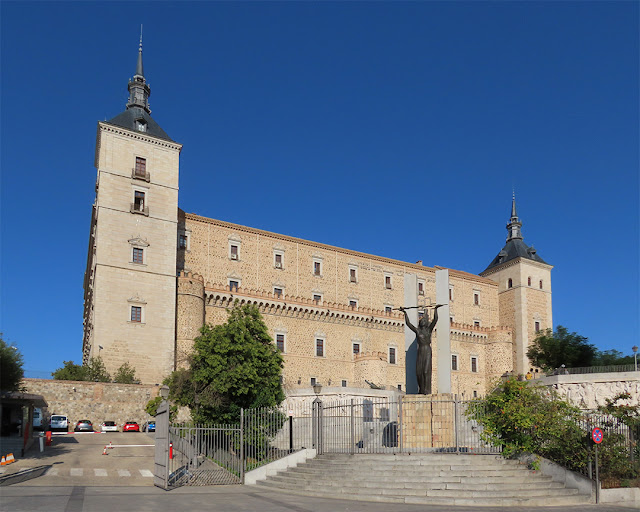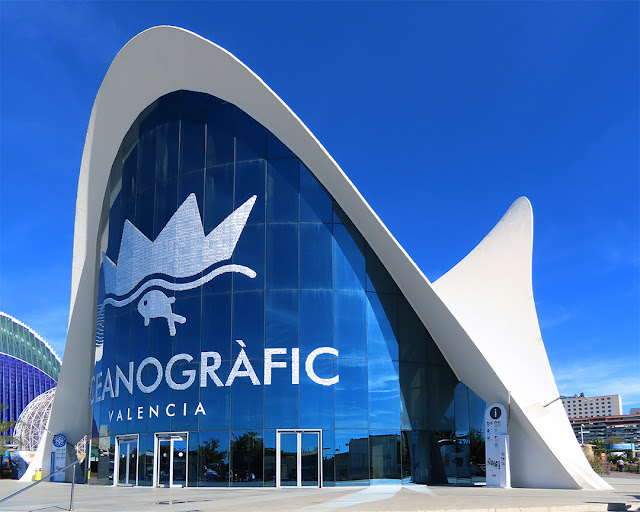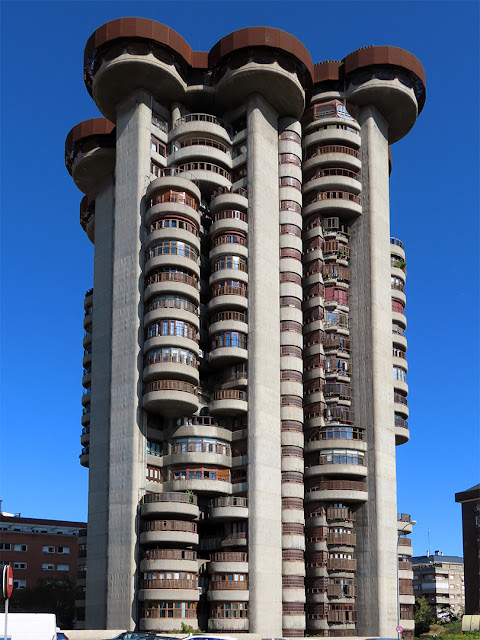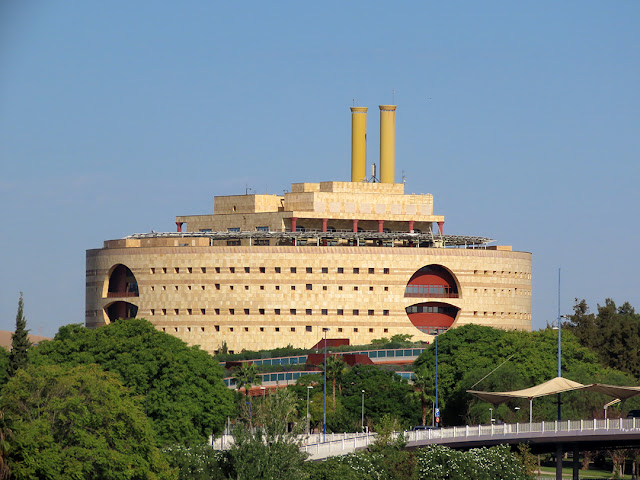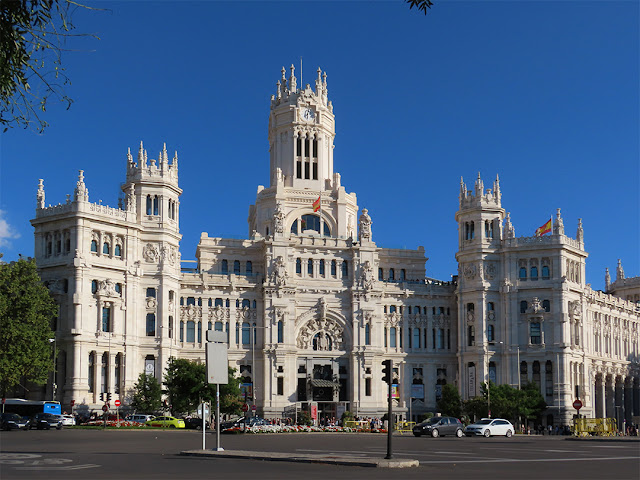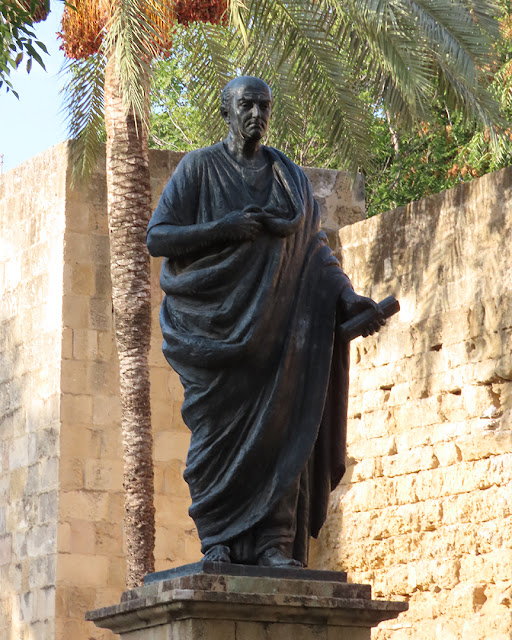Tuesday, February 28, 2023
Monday, February 27, 2023
Victoria
“Victoria” (Victory) by Juan de Ávalos, 1961
Monumento a la gesta del Alcázar
Calle de la Union
Toledo, September 2022
“The origin of the name Zocodover comes from the Arabic language sūq ad-dawābb, which means ‘market of burden beasts’. This place was also the place where bullfighting and the cucañas were organized in the celebrations of the locality. It has been, therefore, the nerve center of the social life of the city since medieval times. But Zocodover was also a center for more mournful acts like the autos-da-fé of the Inquisition or the public execution of the prisoners. It is when the old square was destroyed by a fire on October 29, 1589 that the decision was taken to build a new one. In 1854 an ambitious project is drawn up, by the hand of the technician Santiago Martín Ruiz, to reorganize the plaza de Zocodover, transforming it into a rectangular portico square.” (Plaza de Zocodover, Wikipedia)
Sunday, February 26, 2023
Palazzo Pretorio
Palazzo Pretorio
Piazza dei Priori
Volterra, September 2021
“The ‘Palazzo Pretorio’ with its humorous additions forms one side of the Piazza dei Priori. The palazzo seen today is the result of XIX century changes after the earthquake when several buildings were joined together and further embellished. In the past these buildings housed the Mayor's seat as well as providing accommodation for the Captain of the people's guard, hence its name of Praetorian or Pretorio. The palazzo's tower, the ‘Torre del Procellino’ is thought to be one of the oldest in the city. Its name translates simply as the Tower of the Little Pig because perched high up at the top of the tower next to a window is a quirky carved statue of a stone pig sitting on a little shelf. A careful observer, however, will spot that the tower has more than one pig. Another one is roughly carved in relief at the tower's base.” (Palazzo Pretorio and Torre del Porcellino, ItalyGuide.it)
Saturday, February 25, 2023
Rana de la fortuna
Rana de la fortuna (Lucky Frog) by Eladio de Mora, 2014
Paseo de Recoletos
Madrid, September 2022
“Lucky Frog (Rana de la fortuna) is a bronze sculpture by the Spanish artist dEmo, installed in Madrid, Spain, in 2014, outside the Casino Gran Madrid on the Paseo de Recoletos. The sculpture is 5 metres (16 ft) tall and weighs 2,000 kilograms (4,400 lb). The work was commissioned for the opening of the casino, and was a gesture of thanks to the city for restoring legal gambling after 90 years. It was unveiled on 3 April 2014 by journalist Carme Chaparro and actor Paco León. The frog is a sign of good fortune in Feng shui and its underbelly is engraved with symbols of good luck from world cultures. The 34 symbols include several numbers as well as pictures including a scarab artifact, a four-leaf clover, the peace sign and various currency symbols and religious signs. The patina, the protective coating on the metal, was applied by specialist Juan Manuel González. Its turquoise green is also considered lucky.” (Lucky Frog, Wikipedia)
Friday, February 24, 2023
San Bartolo
Church of San Bartolo
Via San Matteo
San Gimignano, September 2021
“Bartolo da San Gimignano (1228 – 12 December 1300) - born Bartolo Buonpedoni - was an Italian Roman Catholic priest and a professed member from the Third Order of Saint Francis. Bartolo was born to nobles near Siena and fled home to become a priest to escape his father's wrath. He tended to poor people in the streets and used his income to provide alms to them and to alleviate their suffering while himself contracting a disease from working with the poor and succumbing to that same disease as a result. His beatification received approval from Pope Pius X on 27 April 1910.” (Bartolo da San Gimignano, Wikipedia)
Thursday, February 23, 2023
Statue of Maimónides
Statue of Maimónides by Amadeo Olmos Ruiz, 1964
Plaza de Tiberíades
Córdoba, September 2022
“Maimonides was born in Cordoba on 30th March 1135, from a notable Cordoban family - his father was a lawyer and a leader of the Jewish Quarter, or judería. He received his early education in the synagogue school, but his studies of mathematics and medicine were written in Arabic. After an edict against the Jews, he was forced to leave Spain and travelled to a number of cities before settling in Cairo, where he worked as a merchant of precious stones. Maimonides was the greatest, most universal and the most influential Jewish-Cordoban thinker. He left a wide and varied series of works both in Arabic and Hebrew – medical treatises, theological writings and philosophical tracts. Jewish thinking reached its zenith with the writings of Maimonides, and he was named nagid (chief) by the Jewish community. He died in Cairo on 12th December 1204.” (Maimónides, Turismo de Córdoba)
Wednesday, February 22, 2023
Teatro Persio Flacco
Teatro Persio Flacco (Persio Flacco Theater)
Via dei Sarti
Volterra, September 2021
“The Persio Flacco is an active opera and theater stage in Volterra, Italy. Volterra still lacked a proper indoor performance stage in the early nineteenth century. In 1816 a group of citizens, including cavaliere Bartolommeo Falchi, cavaliere Mario Maffei, Luigi Ducci, Francesco Cinci, and Luigi Campani, commissioned the architect Luigi Campani (an architect of the Grand Duke Ferdinand III of Tuscany). The theater was erected on the site of the palazzo belonging to Marchesi Incontri. Work began in 1816 and the theater was inaugurated in 1820. The main curtain (sipario) was painted by Nicola Contestabili, who represented Aulus Persius Flaccus, a Roman satirist and playwright born in Volterra, being led by the muses to the summit of Parnassus, ruled by Apollo. This gave the theater its final name. The ceiling over the seats was painted with Venus in a chariot drawn by swans, and the parapets, with cupids, garlands and vignettes, harmonizing with the curtain. All these beautiful decorations were lost with subsequent restorations. In 1820, a group of 60 prominent citizens formed the Academy of the Riuniti (of the reunited), and purchased the entire theater, assigning to each member property of the individual boxes and seats, and this organization has continuously maintained that theatrical activity. The theater was closed for physical repairs for 15 years, from 1984 to 1999, before the reopening, members donated their ownerships of seats and boxes to the Academy. This availed them of funds to pursue reconstruction.” (Persio Flacco Theater, Wikipedia)
Tuesday, February 21, 2023
Templete del Triunfo
Templete del Triunfo de Nuestra Señora del Patrocinio by José Tomás Zambrano, 1756
Calle Santo Tomás, Plaza del Triunfo
Seville, September 2022
Monday, February 20, 2023
Pipe organ
Pipe organ
Collegiata di Santa Maria Assunta
Piazza del Duomo
San Gimignano, September 2021
“The wall of the left aisle had six decorated bays, of which the paintings of the first bay are in poor condition and those of the sixth have been damaged and in part destroyed by the insertion of the pipe organ. The remaining paintings, with the exception of a repainted panel in the sixth bay, are the work of Bartolo di Fredi, and, according to an inscription, were completed around 1356. The paintings are in three registers and proceed from left to right chronologically in each register.” (Collegiata di Santa Maria Assunta, Wikipedia)
Sunday, February 19, 2023
L'Oceanogràfic
L'Oceanogràfic (The Oceanographic)
Carrer d'Eduardo Primo Yúfera
Ciutat de les Arts i de les Ciències (City of Arts and Sciences)
Valencia, September 2022
“The Oceanographic is the largest complex of its type in Europe, spanning 110,000 square metres (1,200,000 sq ft) and holding a capacity of 42,000,000 litres (11,000,000 US gal) of water, including a 26,000,000-litre (6,900,000 US gal) dolphinarium and a 7,000,000-litre (1,800,000 US gal) ocean tank with sharks, rays and other fish. It is home to 45,000 animals from 500 different species—including sharks, penguins, dolphins, sea lions, walruses, beluga whales, birds, reptiles and invertebrate—all inhabiting nine two-tiered underwater towers representing the Earth's major ecosystems. The aquariums utilize sea water pumped from the La Malva-Rosa beach. The park is divided into ten areas: the marine areas are arranged into Mediterranean habitats, the Arctic oceans, islands, the tropics, the temperate seas and the Red Sea. The park also includes a dolphinarium, an area of mangrove swamps and marshland, and a garden with more than 80 different species of plants.” (L'Oceanogràfic, Wikipedia)
Saturday, February 18, 2023
Church of San Lino
“Stories of the Life of Christ” by Cosimo Daddi, 1618ca
Church of San Lino
Via San Lino
Volterra, September 2021
“San Lino is a Renaissance-style, Roman Catholic church and former monastery in Volterra, region of Tuscany, Italy. It is located on Via San Lino in the historic center of the town. The adjacent former Franciscan order nunnery, now a hotel, was founded in 1480, supposedly on the home of the first-century saint and Pope Linus, who putatively followed Peter as the second pope and of whom little else can be documented. Legend holds that he was born in Volterra. Raffaelo Maffei, a native citizen who had been theologian for both Popes Julius II and Sixtus IV, endowed construction of the church and enlargement of the adjacent monastery (1517) at a cost of 80,000 scudi. The plain facade and portal were completed by 1513. The presbytery of the church contains a memorial bust (1522) of Maffei by Silvio da Fiesole (Silvio Cosini) with flanking statues of the Archangel Raphael and Beato Gerardo on his tomb by Fra Giovanni Angelo Montorsoli and Stagio Stagi. The interior ceiling is decorated with framed lunettes frescoed with images and scenes, including twelve Stories of the Life of Christ (circa 1618) by Cosimo Daddi. The church has a main altarpiece painted on wood with a Virgin and San Lino (1597) painted by Francesco Curradi, a Birth of Mary (17th century) by Cesare Dandini, and a Visitation also by Daddi.” (San Lino, Wikipedia)
Friday, February 17, 2023
Delegación del Gobierno
Delegación del Gobierno
Plaza de Zocodover
Toledo, September 2022
“The origin of the name Zocodover comes from the Arabic language sūq ad-dawābb, which means ‘market of burden beasts’. This place was also the place where bullfighting and the cucañas were organized in the celebrations of the locality. It has been, therefore, the nerve center of the social life of the city since medieval times. But Zocodover was also a center for more mournful acts like the autos-da-fé of the Inquisition or the public execution of the prisoners. It is when the old square was destroyed by a fire on October 29, 1589 that the decision was taken to build a new one. In 1854 an ambitious project is drawn up, by the hand of the technician Santiago Martín Ruiz, to reorganize the plaza de Zocodover, transforming it into a rectangular portico square.” (Plaza de Zocodover, Wikipedia)
Thursday, February 16, 2023
Iridescenze
“Iridescenze” (Iridescences) rose window by Marcello Aitiani, 2003
Collegiata di Santa Maria Assunta
Piazza del Duomo
San Gimignano, September 2021
Wednesday, February 15, 2023
Torres Blancas
Torres Blancas by Francisco Javier Sáenz de Oiza, 1969
Avenida de América
Madrid, September 2022
“Torres Blancas is a mixed use concrete building in Madrid, Spain, designed in 1961 by Spanish architect Francisco Javier Sáenz de Oiza. The structure is a noted example of Spanish Organicism. Spanish industrialist Juan Huarte commissioned the project which initially included two residential towers.” (Torres Blancas, Wikipedia)
Tuesday, February 14, 2023
Our Lady of the Assumption
“L'Assunta che dona la cintola a San Tommaso” by Giovanni della Robbia, 1520
Oratorio di Sant'Antonio Abate
Via di Sotto
Volterra, September 2021
Monday, February 13, 2023
Statue of Averroes
Statue of Averroes by Pablo Yusti Conejo, 1967
Calle Cairuan
Córdoba, September 2022
“In an attractive setting, in front of the city walls, stands a magnificent statue of a seated man, deep in thought, but revealing at the same time all his dynamism, energy and inner drive. It is the statue of the most outstanding of all the Cordoban Arab writers and arguably the most influential philosopher of the Arab world, the great Averroes (1126-1198). He was born in Cordoba in 1226, the same year his grandfather died. His grandfather had been qadi (Moslem religious judge), civil judge and an important official in Cordoba – positions his father now held. Averroes followed suit, and for his contemporaries he was better known as a judge than as a philosopher. He was a highly-educated man who led a profoundly intellectual existence and who won fame as a doctor, astronomer, expert in law and above all, as a philosopher. In 1153 he was in Morocco masterminding reforms in higher education for the Almohad sultan. In 1169 he was named qadi of Seville, but he returned to Cordoba two years later as qadi, although he constantly travelled back and forth to Seville and Morocco. He was named qadi for a second time in Seville in 1179, and returned three years later as Great qadi of Cordoba. A few months previously he had replaced Ibn Tufayl as the sultan’s personal physician, continuing when Almanzor came to power (1184); he retained this position for good, only interrupted by a faux pas in 1195 which led to a short period of exile in Lucena. Once in the ruler’s good books again, he returned to the court in 1198, but this time in Morocco, where he put the finishing touches to his works for the few months remaining before his death.” (Averroes, Turismo de Córdoba)
Sunday, February 12, 2023
The Martyrdom of St Sebastian
“The Martyrdom of St Sebastian” by Benozzo Gozzoli, 1465
Collegiata di Santa Maria Assunta
Piazza del Duomo
San Gimignano, September 2021
“On the rear wall of the nave, beneath the Last Judgement is a fresco of the Martyrdom of St Sebastian painted by Benozzo Gozzoli in 1465. The work was commissioned by the people of San Gimignano as the result of a vow that they made to honour the saint, whose intervention was believed to have brought relief from an outbreak of plague in 1464. The painting shows the figure of Christ and the Virgin Mary in Glory, while below, St Sebastian, standing on a Classical plinth and bristling with arrows, suffers martyrdom and is crowned by angels. Benozzo Gozzoli received his training under Lorenzo Ghiberti while working on the Baptistry doors.[19] He fulfilled two other important commissions in San Gimignano. Both were at the Church of Sant' Agostino, a fresco cycle of the life of St Augustine of Hippo executed 1464-65, and another St Sebastian, showing the townsfolk sheltering beneath his cloak.” (Collegiata di Santa Maria Assunta, Wikipedia)
Saturday, February 11, 2023
Torre Triana
Torre Triana by Francisco Javier Sáenz de Oiza, 1993
Calle Juan Antonio de Vizarrón
Seville, September 2022
“Torre Triana, an administrative building of the Government of Andalusia in Seville, was built in 1993. It was designed by the Navarran architect Francisco Javier Saenz de Oiza, inspired from the Sant'Angelo castle of the city of Rome. It is the largest administrative building of the Government of Andalusia. Postmodern style with the yellow color and circular shape makes the building very particular.” (Torre Triana, Architectuul)
Friday, February 10, 2023
Baptismal font
Baptismal font by Giovanni Vaccà, 1759
Statue of St John the Baptist by Giovanni Antonio Cybei, 1771
Battistero di San Giovanni (Baptistery of San Giovanni)
Piazza San Giovanni
Volterra, September 2021
“It has a painting (partially damaged during World War Two of the Assumption of the Virgin by Niccolò Circignani. Beside that altar is a marble font (1502) is by Andrea Sansovino. The Ciborium (1471) was completed by Mino da Fiesole. The baptismal font (1759) by Giovanni Vaccà. Above it rises a statue of St John the Baptist (1771) by Giovanni Antonio Cybei. The holy water receptacle is an ancient Roman sarcophagus.” (Volterra Baptistery of San Giovanni, Wikipedia)
Thursday, February 9, 2023
Catedral de Santa María
Catedral de Santa María
Plaza de la Virgen
Valencia, September 2022
“Valencia Cathedral, at greater length the Metropolitan Cathedral–Basilica of the Assumption of Our Lady of Valencia, also known as St Mary's Cathedral, is a Roman Catholic church in Valencia, Spain. The cathedral was consecrated in 1238 by the first bishop of Valencia after the Reconquista, Pere d'Albalat, Archbishop of Tarragona, and was dedicated to Saint Mary by order of James I the Conqueror. It was built over the site of the former Visigothic cathedral, which under the Moors had been turned into a mosque. Valencian Gothic is the predominant architectural style of the cathedral, although it also contains Romanesque, French Gothic, Renaissance, Baroque and Neoclassical elements. The cathedral contains numerous 15th-century paintings, some by local artists (such as Jacomart), others by artists from Rome engaged by the Valencian Pope Alexander VI who, when still a cardinal, made the request to elevate the Valencian See to the rank of metropolitan see, a category granted by Pope Innocent VIII in 1492.” (Valencia Cathedral, Wikipedia)
Wednesday, February 8, 2023
Duomo di San Gimignano
Collegiata di Santa Maria Assunta
Piazza del Duomo
San Gimignano, September 2021
“The Collegiate Church stands on the west side of Piazza del Duomo, so named although the church has never been the seat of a bishop. The church has an east-facing facade, and chancel to the west, as at St Peter's Basilica. The architecture is 12th and 13th century Romanesque with the exception of the two chapels in the Renaissance style. The facade, which has little ornament, is approached from the square by a wide staircase and has a door into each of the side aisles, but no central portal. The doorways are surmounted by stone lintels with recessed arches above them, unusual in incorporating the stone Gabbro. There is a central ocular window at the end of the nave and a smaller one giving light to each aisle. The facade, which is stone, was raised higher in brick in 1340, when the ribbed vaulting was constructed, and the two smaller ocular windows set in. Matteo di Brunisend is generally credited as the main architect of the medieval period, with his date of activity given as 1239, but in fact his contribution may have been little more than the design of the central ocular window. Beneath this window is a slot which marks the place of a window which lit the chancel of the earlier church, and may be the most visible sign of the church's reorientation in the 12th century rebuilding, although this is not entirely agreed upon by scholars.” (Collegiata di Santa Maria Assunta, Wikipedia)
Tuesday, February 7, 2023
Torreón occidental
Torreón occidental (Western tower) Puente de Alcántara
Toledo, September 2022
“During the reign of Alfonso X of Castile it suffered serious damage and was rebuilt. The western tower belongs to this period, later decorated under the reign of the Catholic Monarchs, whose arms decorate its walls. The fruit of the pomegranate (the emblem of Granada) is missing from them, because the Reconquista had not finished at that time.” (Puente de Alcántara, Wikipedia)
Monday, February 6, 2023
Baptistery of San Giovanni
Battistero di San Giovanni (Baptistery of San Giovanni)
Piazza San Giovanni
Volterra, September 2021
“The Baptistery of San Giovanni an octagonal thirteenth-century religious building standing just in front of the Duomo of Volterra, in the center of the city. It was supposedly set up in the seventh century at the site of a Roman temple dedicated to Sun worship. The façade is decorated with horizontal bands of white and dark green marble. The Romanesque Portal has been attributed to a follower of Nicola Pisano. The sixteenth-century altar inside has been assigned to Balsimelli da Settignano, using a design by Mino da Fiesole.” (Volterra Baptistery of San Giovanni, Wikipedia)
Sunday, February 5, 2023
Palacio de Cibeles
Palacio de Cibeles by Antonio Palacios and Joaquín Otamendi, 1919
Plaza de Cibeles
Madrid, September 2022
“Cibeles Palace (Palacio de Cibeles), formally known as Palacio de Comunicaciones (Palace of Communications) and Palacio de Telecomunicaciones (Palace of Telecommunications) until 2011, is a complex composed of two buildings with white facades and is located in one of the historical centres of Madrid, Spain. Formerly the city's main post office and telegraph and telephone headquarters, it is now occupied by Madrid City Council, serving as the city hall, and the public cultural centre CentroCentro.” (Cybele Palace, Wikipedia)
Saturday, February 4, 2023
Santa Maria Assunta
Collegiata di Santa Maria Assunta
Piazza del Duomo
San Gimignano, September 2021
“The Collegiata di Santa Maria Assunta or Duomo di San Gimignano is a Roman Catholic collegiate church and minor basilica in San Gimignano, in Tuscany in central Italy. It contains important cycles of Renaissance frescoes by artists including Domenico Ghirlandaio, Benozzo Gozzoli, Taddeo di Bartolo, Lippo Memmi and Bartolo di Fredi. It falls within the UNESCO World Heritage Site of the ‘Historic Centre of San Gimignano’, with its frescoes being described by UNESCO as ‘works of outstanding beauty’.” (Collegiata di Santa Maria Assunta, Wikipedia)
Friday, February 3, 2023
Statue of Seneca
Statue of Seneca by Amadeo Ruiz Olmos, 1965
Calle Puerta de Almodóvar
Córdoba, September 2022
“This monument to the Cordoban philosopher stands next to Puerta de Almodovar. Seneca was born in Cordoba in the 4th year B.C. and then went to Rome to complete his studies. During the reign of Claudius, he was a member of the senate, and around 50 A.D. was named a praetor by Nero, and in 56, a consul. Several years later, he retired and dedicated his time to reading, meditation and writing some of his best philosophical works. He had studied alongside grammarians, philosophers and rectors, and all his work was imbued with the Stoic doctrine. Seneca tried his hand at a range of literary styles, of which only some of his tragedies but most of his philosophical works have survived to this day, and the topics he mainly dealt with were ethical issues, theological problems and political theory. One of his most important works in the treatise On the Tranquillity of the Soul, written during his decline. However, the end of his life was far from tranquil, and he was accused of conspiracy and sentenced to death by Nero, although Seneca preferred to take his own life instead.” (Séneca, Turismo de Córdoba)
Thursday, February 2, 2023
Bell tower of the cathedral
Bell tower
Cattedrale di Santa Maria Assunta
(Cathedral of Santa Maria Assunta)
Piazza San Giovanni
Volterra, September 2021
“Nicola Pisano is said to have been involved in further reconstruction in the mid 13th century. The rustic stone façade was built in Romanesque style using spolia from the Roman theater of Volterra in the portal. The intarsia over the door is attributed to Pisano. In 1580, bishop Guido Serguidi, with the approval of Ferdinando I de' Medici, Grand Duke of Tuscany, commissioned the decoration of the intricately coffered ceiling of the nave and crossings, designed by Francesco Capriani, carved by Jacopo Pavolini, and gilded by Fulvo della Tuccia. The ceiling has sculpted reliefs of Saints Ugo, Giusto, Pope Linus, Clemente, Attinea, and Greciniana, round a central symbol of the Holy Spirit. The campanile of 1493 replaced an older belltower.” (Volterra Cathedral, Wikipedia)
Wednesday, February 1, 2023
Torre del Oro
Torre del Oro
Paseo de Cristóbal Colón
Seville, September 2022
“The Torre del Oro (Arabic romanized: burj aḏẖ-ḏẖahab, lit. Tower of Gold) is a dodecagonal military watchtower in Seville, southern Spain. It was erected by the Almohad Caliphate in order to control access to Seville via the Guadalquivir river. Constructed in the first third of the 13th century, the tower served as a prison during the Middle Ages. Its name comes from the golden shine it projected on the river, due to its building materials (a mixture of mortar, lime and pressed hay). The tower is divided into three levels, the first level, dodecagonal, was built in 1220 by order of the Almohad governor of Seville, Abù l-Ulà; As for the second level, of only 8 meters, also dodecagonal, was built by Peter of Castile in the fourteenth century, a hypothesis that has been confirmed by archaeological studies; The third and uppermost being circular in shape was added after the previous third level, Almohad, was damaged by the 1755 Lisbon earthquake. Rebuilding of the third level was made by Brusselian military engineer Sebastian Van der Borcht in 1760.” (Torre del Oro, Wikipedia)
Subscribe to:
Posts (Atom)


